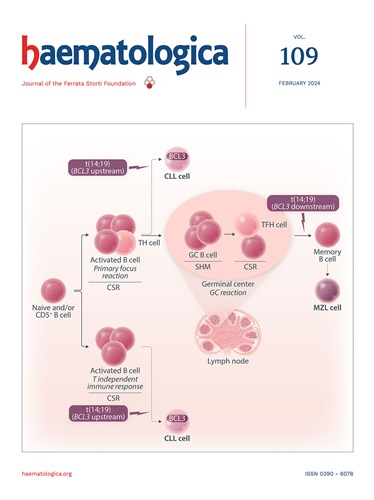Changing donors improves outcomes of second transplantation in patients who experienced graft failure after first allogeneic stem cell transplantation.
IF 8.2
1区 医学
Q1 HEMATOLOGY
引用次数: 0
Abstract
A second transplantation is almost the only salvage for patients encountering graft failure (GF) following the first allogeneic stem cell transplantation. However, there were no standard protocols for second transplantations, and the role of changing donors remained controversial. We retrospectively studied 272 consecutive patients from 18 Chinese centers undergoing second transplantations due to GF, aiming to assess the impact of changing donors and factors affecting second transplantation outcomes. The primary endpoint was neutrophil engraftment. Other endpoints included platelet engraftment, graft versus host disease (GVHD), transplant related mortality (TRM), relapse, and survival. Of the 272 patients, 193 (71.0%) patients experienced primary GF, and 70.6% (192) used a different second donor. Neutrophil engraftment was achieved in 218 (86.3%) patients by d28, and platelet engraftment was achieved in 164 (70.0%) patients by d100. The 3-year cumulative incidence of acute GVHD, chronic GVHD, relapse, and TRM were 43.5%, 27.8%, 15.6%, and 44.6%, respectively. The 1-year and 3-year overall survival (OS) were 56.1% and 49.5%, respectively. Compared to using the same donor, changing donors significantly improved neutrophil (92.4% vs 71.4%, p.改变供体可以改善第一次同种异体干细胞移植失败患者的第二次移植结果。
第二次移植几乎是第一次同种异体干细胞移植后患者遭遇移植物衰竭(GF)的唯一补救措施。然而,对于第二次移植没有标准的方案,并且改变供体的作用仍然存在争议。我们回顾性研究了来自中国18个中心的272例因GF而接受第二次移植的患者,旨在评估供体改变的影响和影响第二次移植结果的因素。主要终点是中性粒细胞植入。其他终点包括血小板植入、移植物抗宿主病(GVHD)、移植相关死亡率(TRM)、复发和生存。在272例患者中,193例(71.0%)患者经历了原发性GF, 70.6%(192)患者使用了不同的第二供体。218例(86.3%)患者在d28时实现了中性粒细胞的移植,164例(70.0%)患者在d100时实现了血小板的移植。急性GVHD、慢性GVHD、复发和TRM的3年累积发病率分别为43.5%、27.8%、15.6%和44.6%。1年和3年总生存率(OS)分别为56.1%和49.5%。与使用同一供者相比,更换供者可显著改善中性粒细胞(92.4% vs 71.4%, p。
本文章由计算机程序翻译,如有差异,请以英文原文为准。
求助全文
约1分钟内获得全文
求助全文
来源期刊

Haematologica
医学-血液学
CiteScore
14.10
自引率
2.00%
发文量
349
审稿时长
3-6 weeks
期刊介绍:
Haematologica is a journal that publishes articles within the broad field of hematology. It reports on novel findings in basic, clinical, and translational research.
Scope:
The scope of the journal includes reporting novel research results that:
Have a significant impact on understanding normal hematology or the development of hematological diseases.
Are likely to bring important changes to the diagnosis or treatment of hematological diseases.
 求助内容:
求助内容: 应助结果提醒方式:
应助结果提醒方式:


